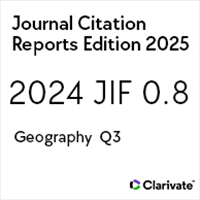Employment dynamics in northern Uruguay border
La dinámica del empleo en la frontera norte de Uruguay
https://doi.org/10.21670/ref.2011.23.a04
Keywords:
border, consumption, prices, employment, integrationAbstract
Uruguay shares a long border with Brazil. There, inhabitants from both sides of the border shop in whichever country they find the cheapest prices. As a consequence of severe changes in the bilateral real exchange rate, the demand moves alternately from side to the other of the border, affecting the level of employment in two Uruguayan border provinces. The theoretical model outlined in this article intends to capture the main elements of the analyzed situation. The econometric estimates carried out validate the stated model and show that the labor markets on both sides of the border are not integrated enough to smooth the impact of demand movements.Resumen
Uruguay comparte una extensa frontera con Brasil. En esta zona, los habitantes de ambas márgenes realizan sus compras en aquel país que coyunturalmente resultan más convenientes. Las fuertes alteraciones que ha sufrido el tipo de cambio real bilateral han determinado que la demanda se haya trasladado a un lado y otro de la frontera de forma alternada, repercutiendo en el nivel de empleo generado en dos departamentos fronterizos de Uruguay. En este artículo se presenta un modelo teórico que intenta recoger los principales elementos del fenómeno analizado. Las estimaciones econométricas realizadas validan el modelo planteado y muestran que los mercados laborales de ambos lados de la frontera no están lo suficientemente integrados como para amortiguar los impactos derivados de las variaciones de la demanda.References
Campbell, Jeffrey y Beverly Lapham (2004), “Real Exchange Fluctuations and the Dynamics of Retail Trade Industries on the U.S. – Canadá Border”, The American Economic Review, 94, 4:1194-1206. DOI: https://doi.org/10.1257/0002828042002723
Correa, Fernando, (2006), “El efecto sustitución y la evolución del costo de vida en la frontera de Uruguay con Brasil”, Estudios Fronterizos, Nueva época, 7, 14:33-54. DOI: https://doi.org/10.21670/ref.2006.14.a02
Engel, Charles y John Rogers (1996), “How Wide is the Border”, The American Economic Review, 86, 5:1112-1125.
Harrell, Louis y Dale Fischer (1989), “The Mexican Peso Devaluation and Border Area Employment”, Southwest Journal of Business & Economics, 6:19-27.
Parley, David y Shang Jin Wei (2001), “Explaining the Border Effect: The Role of Exchange Variability, Shipping Costs, and Geography”, Journal of International Economics, 55, 1: 87-105. DOI: https://doi.org/10.1016/S0022-1996(01)00096-4































